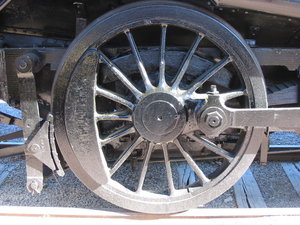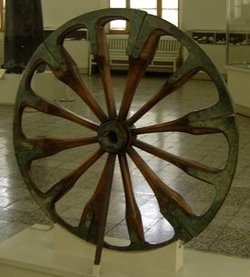Wheel

A wheel is a circular object that, together with an axle, allows low friction in motion, by rolling. Common examples are found in transport applications. More generally the term is also used for circular objects rotating for other purposes, such as a wheel and axle and a flywheel.
Mechanics
Wheels are used in conjunction with an axle, either the wheel turns on the axle or the wheel is rigidly attached to the axle which then turns in bearings in the body of the vehicle. The mechanics are the same in either case.
The low friction (compared to dragging) is explained as follows:
- the sliding distance is reduced, because the sliding takes place between the wheels and the axles or between the axles and the bearings
- the coefficient of kinetic friction μ for the sliding friction is less
Example:
- If dragging a 100 kg object for 10 m along a surface with μ = 0.5, the normal force on Earth is 980 N and the work done (required energy) is 980 × 10 × 0.5 = 4900 joules.
- Now give the object 4 wheels. The normal force between the 4 wheels and axles is the same (in total) 980 N, assume μ = 0.1, finally the most important factor is the wheel diameter (1000 mm) and axle diameter (50 mm). Now while the object still moves 10 m the sliding frictional surfaces only slide over each other a distance of 0.5 m. So work done is 980 x 0.5 x 0.1 = 49 joules.
Additional energy is lost at the wheel to road interface (rolling friction), but it is deformation loss which can be very small. An example would be train wheels on rail tracks). The tradeoff is that a wheeled object in motion carries more momentum than dragging, and thus require an external force in the opposite direction in order to stop the object or change its direction, for example, such as brakes.
History of the wheel
According to most authorities, the wheel was invented in ancient Mesopotamia in the 5th millennium BC, originally in the function of potter's wheels. A possibly independent invention in China dates to around 2800 BC. It is also thought that the invention of the wheel dated back to Ancient India. Though they did not develop the wheel proper, the Olmec and certain other western hemisphere cultures seem to have approached the concept, as wheel-like worked stones have been found on objects identified as children's toys dating to about 1500 BC. The wheel was apparently unknown in sub-Saharan Africa, Australia, and the Americas until relatively recent contacts with Eurasians.

The invention of the wheel thus falls in the late Neolithic and may be seen in conjunction with the other technological advances that gave rise to the early Bronze Age. Note that this implies the passage of several wheel-less millennia, even after the invention of agriculture. Early wheels were simple wooden disks with a hole for the axle. In the early Roman empire, most horse-carts used a design featuring two chords across the wheel. The spoked wheel was invented much more recently, and allowed the construction of lighter and swifter vehicles. The earliest known examples are in the context of the Andronovo culture, dating to ca 2000 BC (see chariot). Celtic chariots introduced an iron rim around the wheel in the 1st millennium BC. The spoked wheel was in continued use without major modification until the early 20th century.
The invention of the wheel turned out to be of great importance not only as a transportation device, but for the development of technology in general, important applications including the water wheel, the cogwheel (see also antikythera mechanism), the spinning wheel, the astrolabe or torquetum. More modern descendents of the wheel include the propeller, the jet engine, the flywheel (gyroscope) and the turbine.
The central importance of the wheel also resulted in its becoming a strong cultural and spiritual metaphor for a cycle or regular repetition (see chakra, reincarnation).
In July 2001, the wheel was the object of an innovative, but non-inventive, patent as a "circular transportation facilitation device". The patent was obtained by John Keogh, a lawyer from Melbourne, Australia, with the declared intention of demonstrating the unfairness and inaccuracy of the modern patent system.
References
- ^ Casson, Lionel, "Travel in the Ancient World", The Johns Hopkins University Press, Baltimore, 1994.
- ^ http://news.bbc.co.uk/hi/english/world/asia-pacific/newsid_1418000/1418165.stm
Wheeled vehicles
Vehicles are classified according to number of wheels:
See also
- Wheel and axle, simple machine
- Tire
- Bicycle wheel
- Driving wheel
- Hubcap
- Reverse rotation effect
- Rolling friction
- Square wheel
- Wheel Sizing
- Breaking wheel, a form of torture
- Color wheel
- Ship's wheel
Other options
Ground transport devices without wheels include
